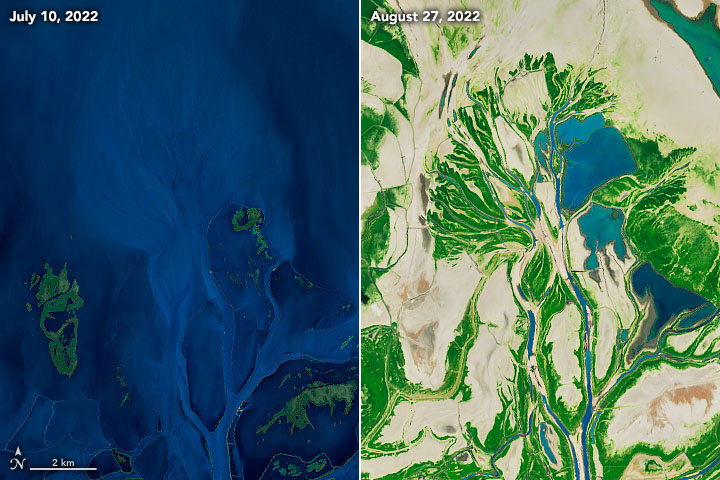[:ja]NASAの地球観測衛星Landsat 8が撮影した中国、鄱陽湖が干上がっている様子です。

鄱陽湖(はようこ)は、中国江西省北部、長江南岸にある湖で、中国最大の淡水湖です。贛江・撫河・信江・鄱江(饒河)・修水などの長江支流が流入し、湖の表面積は、季節により146km2から3,210km2まで変動し、長江(揚子江)の水流を調節する役目を果たしていますが、近年では水位が下がり続け、今年は画像のように、かなりの部分が干上がっています。また、鄱陽湖は渡り鳥の生息地で鳥見が楽しめ、冬にはソデグロヅル、ナベヅル、コウノトリが飛来します。魚の宝庫で漁業が盛んですが、乱獲などにより数が減り、現在では完全に禁漁となっています。絶滅危惧種のヨウスコウカワイルカが生息、保護を受けており、1992年3月にはラムサール条約登録地になりました。
地上の様子はこちらです。

参考文献: NASA Earth’s Tweet, Parched Poyang Lake (NASA Earth Observatory)
地球俯瞰画像を見る: LiVEARTH
[Earthview Wonders] No.1635: Parched Poyang Lake🇨🇳
NASA’s Landsat 8 captured the drought of Poyang Lake, China.

Poyang Lake (鄱陽湖), located in Jiujiang, is the largest freshwater lake in China. The lake is fed by the Gan, Xin, and Xiu rivers, which connect to the Yangtze through a channel. The area of Poyang Lake fluctuates dramatically between the wet and dry seasons, but in recent years the size of the lake has been decreasing overall, as shown in this image. In a normal year the area of the lake averages 3,500km2. In early 2012, drought, sand quarrying, and the practice of storing water at the Three Gorges Dam lowered the area of the lake to about 200km2. The lake provides a habitat for half a million migratory birds[6] and is a favorite destination for birding. During the winter, the lake becomes home to many migrating Siberian cranes, up to 90% of which spend the winter there.
The local scenery on the ground is as follows.

Reference: NASA Earth’s Tweet, Parched Poyang Lake (NASA Earth Observatory)
See earthview photo gallery: LiVEARTH[:]